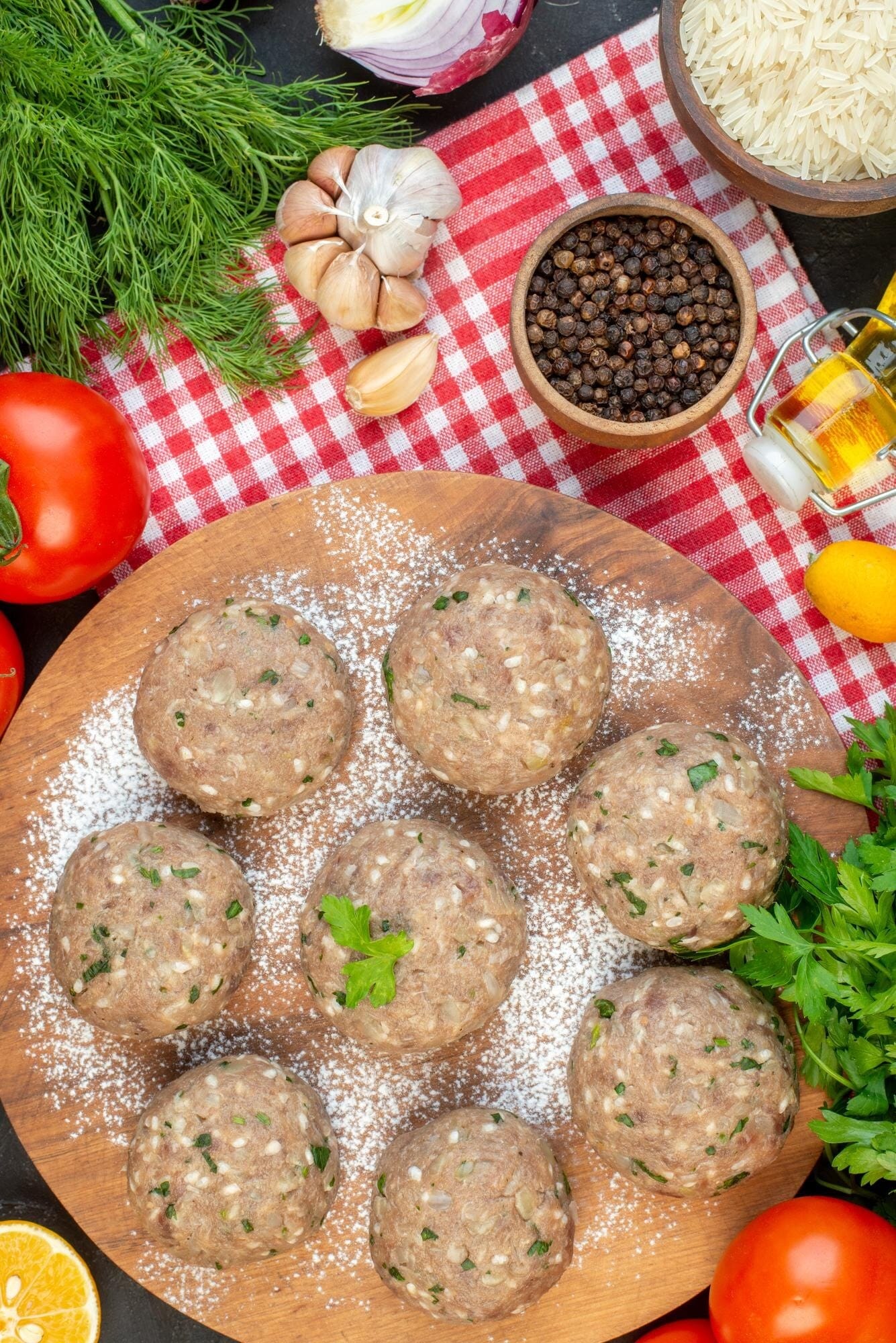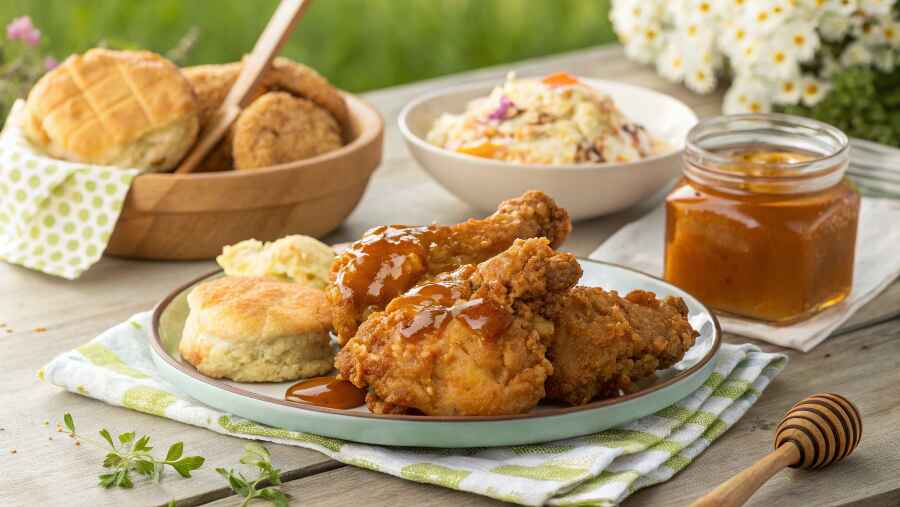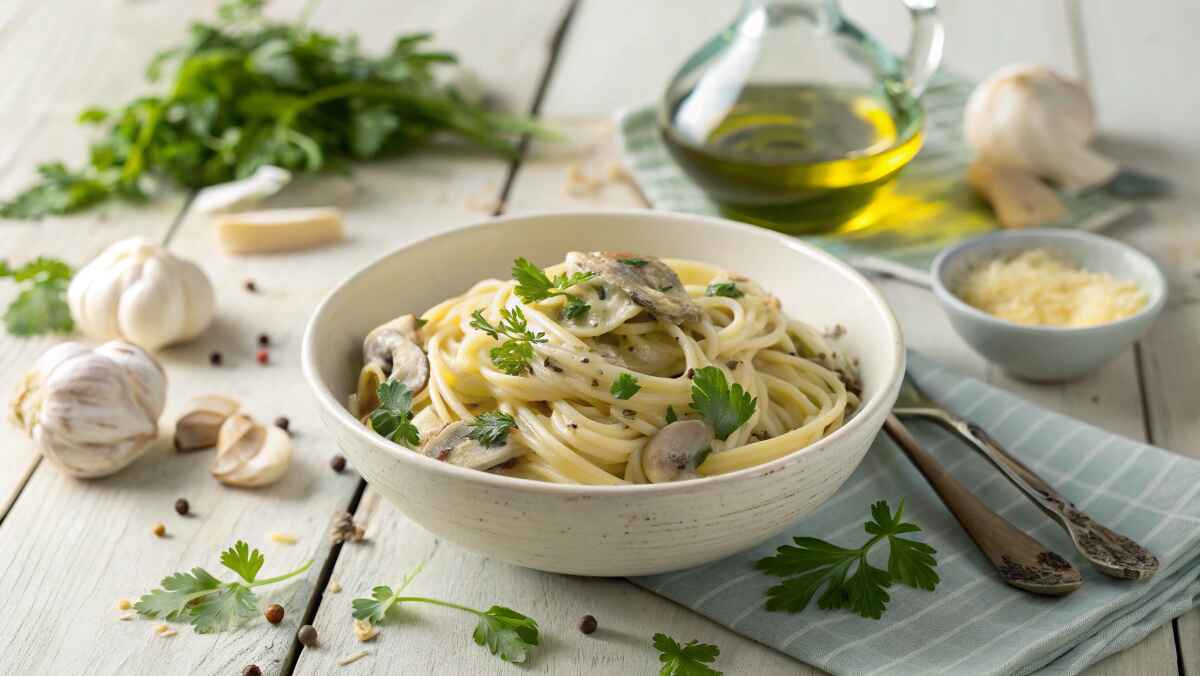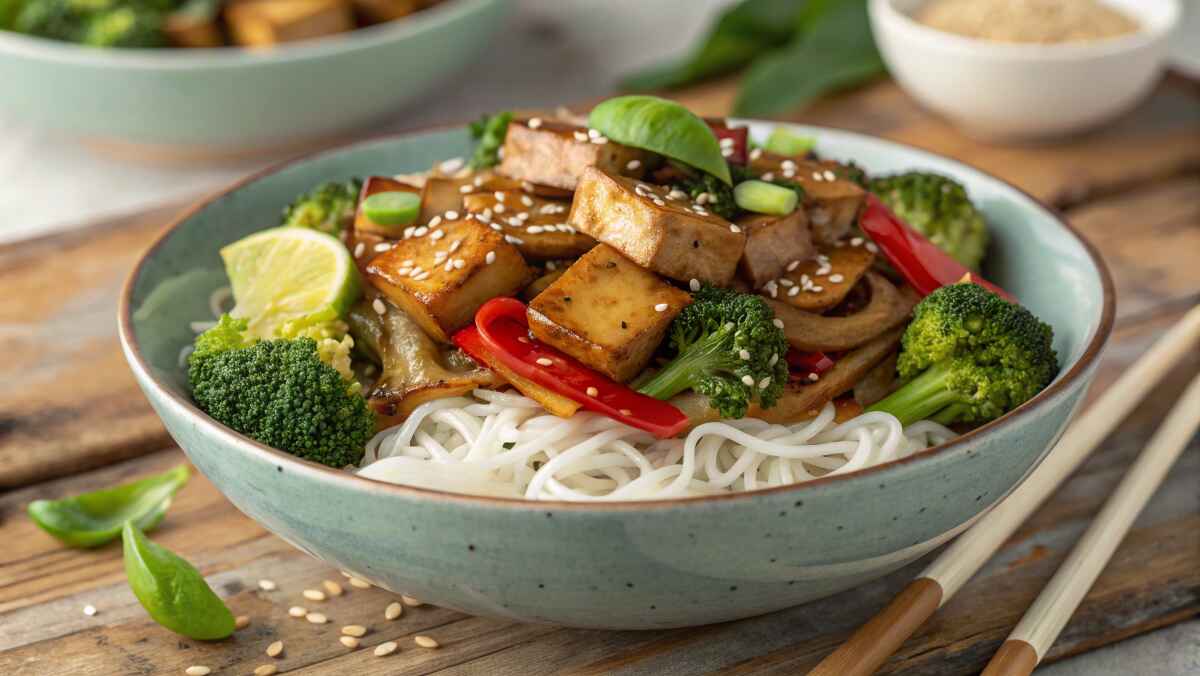Are meatballs gluten-free? This question is common among people with gluten intolerance, celiac disease, or those following a gluten-free lifestyle. While meatballs may seem simple, traditional recipes often contain gluten-containing ingredients like breadcrumbs, flour, and sauces. However, with a few adjustments, you can enjoy delicious gluten-free meatballs without compromising on taste or texture.
In this guide, you’ll discover:
✅ What makes meatballs gluten-free or not
✅ The best gluten-free substitutes for breadcrumbs
✅ How to make homemade gluten-free meatballs
✅ Store-bought gluten-free meatball options
✅ Tasty ways to serve gluten-free meatballs
If you love exploring different gluten-free options, check out this article on gluten-free muffins for more inspiration!
What Makes Meatballs Gluten-Free (or Not)?
Common Ingredients That Contain Gluten
If you are wondering are meatballs gluten-free, you must check the ingredients carefully. Many traditional meatball recipes include gluten, often in the following forms:
- Breadcrumbs – The most common binder in meatballs, but regular breadcrumbs contain wheat.
- Flour – Some recipes coat meatballs in flour before frying, adding unnecessary gluten.
- Soy Sauce – Often found in Asian-style meatballs, but most soy sauces contain wheat.
- Packaged Sauces – Many store-bought marinara or gravy sauces contain gluten-based stabilizers.
- Pre-Made Spice Mixes – Some seasoning blends have hidden gluten from wheat-based fillers.
How to Make Sure Meatballs Are Gluten-Free
If you’re following a gluten-free diet, it’s important to ensure your meatballs are 100% free from gluten contamination. While meat itself is naturally gluten-free, many traditional meatball recipes include hidden sources of gluten that could pose a risk to those with celiac disease or gluten sensitivities. To fully enjoy safe and delicious gluten-free meatballs, follow these essential steps:
1. Use Gluten-Free Binders Instead of Regular Breadcrumbs
One of the main reasons traditional meatballs contain gluten is the use of breadcrumbs as a binder. Breadcrumbs help hold the meat together and give the meatballs a light, tender texture. However, most store-bought breadcrumbs contain wheat, making them unsuitable for a gluten-free diet.
Best Gluten-Free Alternatives for Meatball Binders:
✔️ Almond Flour – A fantastic low-carb, gluten-free alternative that adds a slightly nutty flavor.
✔️ Gluten-Free Breadcrumbs – Available in most grocery stores, these provide a similar texture to traditional breadcrumbs.
✔️ Oats (Certified Gluten-Free) – Helps bind the meatballs while adding fiber and a slightly chewy texture.
✔️ Crushed Gluten-Free Crackers – Mimics the texture and absorbency of breadcrumbs.
✔️ Mashed Potatoes or Cooked Quinoa – A soft, nutritious option that adds moisture to the meatballs.
When using gluten-free alternatives, make sure they are certified gluten-free to avoid cross-contamination.
2. Check Labels on Sauces and Seasonings for Hidden Gluten
Many store-bought sauces, spice blends, and condiments contain hidden gluten in the form of wheat-based thickeners, stabilizers, or preservatives.
Common Ingredients That May Contain Gluten:
🚫 Soy Sauce – Most traditional soy sauce contains wheat. Opt for gluten-free tamari or coconut aminos instead.
🚫 Worcestershire Sauce – Some brands contain barley malt, a gluten source. Look for gluten-free labeled versions.
🚫 Pre-Made Marinara or Pasta Sauces – Many contain modified food starch or flour-based thickeners. Always check the label.
🚫 Packaged Spice Blends – Some seasoning mixes include wheat-based fillers or anti-caking agents. Stick to pure spices or gluten-free certified blends.
How to Stay Safe:
✔️ Read ingredient labels carefully – If a product isn’t labeled gluten-free, assume it may contain gluten.
✔️ Make homemade sauces when possible – Try a simple homemade marinara sauce with crushed tomatoes, garlic, and olive oil.
✔️ Choose individual spices over pre-mixed seasonings – This ensures you’re not getting unexpected gluten ingredients.
Looking for a delicious gluten-free pasta dish to pair with your meatballs? Check out this guide on gluten-free pasta dishes with burrata for a flavorful pairing!
3. Prevent Cross-Contamination in the Kitchen
Even if all your ingredients are gluten-free, cross-contamination can occur if they come into contact with surfaces, cookware, or utensils that have been used for gluten-containing foods. This is especially important for those with celiac disease, as even small traces of gluten can trigger symptoms.
Tips to Avoid Cross-Contamination:
✔️ Use separate cooking utensils, cutting boards, and mixing bowls for gluten-free ingredients.
✔️ Thoroughly clean counters and cookware before preparing gluten-free meatballs.
✔️ Store gluten-free ingredients separately from gluten-containing products to prevent accidental mixing.
✔️ Be cautious when frying or baking – Avoid using the same pan or oven space for gluten-free and gluten-containing foods at the same time.
✔️ Use dedicated gluten-free cooking tools if you frequently prepare gluten-free meals in a shared kitchen.
By following these precautions, you can enjoy safe and worry-free gluten-free meatballs without the risk of gluten exposure.
4. Choose Certified Gluten-Free Ingredients
If you’re unsure whether an ingredient is gluten-free, look for a “Certified Gluten-Free” label. This ensures the product has been tested and meets strict gluten-free standards.
Key Ingredients to Look for with Gluten-Free Certification:
✅ Gluten-Free Breadcrumbs
✅ Gluten-Free Pasta
✅ Gluten-Free Seasoning Blends
✅ Gluten-Free Worcestershire or Soy Sauce
✅ Oats Labeled “Gluten-Free” (Oats are naturally gluten-free, but can be contaminated during processing)
For more information on gluten-free certification, check out: Gluten Intolerance Group – Gluten-Free Certification Organization (GFCO)
How to Make Gluten-Free Meatballs at Home
Best Gluten-Free Breadcrumb Substitutes
If you’re making homemade gluten-free meatballs, here are the best binders:
🔹 Almond Flour – Adds a slightly nutty taste and is great for low-carb diets.
🔹 Certified Gluten-Free Oats – A fiber-rich, budget-friendly alternative.
🔹 Crushed Gluten-Free Crackers – Mimics the texture of regular breadcrumbs.
🔹 Gluten-Free Breadcrumbs – Available in most grocery stores.
🔹 Mashed Potatoes or Cooked Quinoa – Add moisture while acting as a natural binder.
If you love exploring ingredient swaps, check out this comparison of white sweet potatoes vs. regular potatoes to see how different carb sources can impact your diet.
Easy Gluten-Free Meatballs Recipe
Ingredients:

- 1 lb ground beef, turkey, or chicken
- ½ cup almond flour or gluten-free breadcrumbs
- 1 egg
- 1 teaspoon garlic powder
- 1 teaspoon onion powder
- 1 teaspoon Italian seasoning
- ½ teaspoon salt
- ½ teaspoon black pepper
- ¼ cup grated Parmesan cheese (optional)
- 2 tablespoons chopped fresh parsley
- 1 tablespoon olive oil (for frying)
Instructions:
1️⃣ Preheat the oven to 375°F (190°C). Line a baking sheet with parchment paper.
2️⃣ Mix the ingredients – In a bowl, combine ground meat, gluten-free binder, egg, garlic powder, onion powder, Italian seasoning, salt, pepper, Parmesan (if using), and parsley.
3️⃣ Shape the meatballs – Roll into small balls and place them on the baking sheet.
4️⃣ Cook the meatballs –
- Baking: Bake for 20-25 minutes, flipping halfway.
- Pan-Frying: Heat olive oil in a pan and cook until browned, about 8-10 minutes.
5️⃣ Serve and enjoy – Pair with gluten-free pasta, rice, or a salad.
Want to pair your meatballs with a healthy and delicious side dish? Try making a spinach pesto as a flavorful dip!
Are Store-Bought Meatballs Gluten-Free?
If you’re short on time, store-bought gluten-free meatballs can be a convenient option. However, not all pre-packaged meatballs are gluten-free, so always check labels carefully.
Best Store-Bought Gluten-Free Meatball Brands
🔹 Applegate Naturals Gluten-Free Meatballs
🔹 Rosina Gluten-Free Italian-Style Meatballs
🔹 Nature’s Rancher Gluten-Free Turkey Meatballs
🔹 Aldi’s Live G Free Meatballs (seasonal availability)
If you’re interested in meal prep, check out this guide on freezing foods to learn how to store gluten-free meals for later!
How to Serve Gluten-Free Meatballs
Gluten-free meatballs are incredibly versatile and can be served in a variety of delicious ways. Whether you’re looking for a classic Italian-style meal, a protein-packed salad, or a creative low-carb option, there are endless ways to enjoy gluten-free meatballs without compromising on taste or texture.
Classic Gluten-Free Meatball Pairings
Print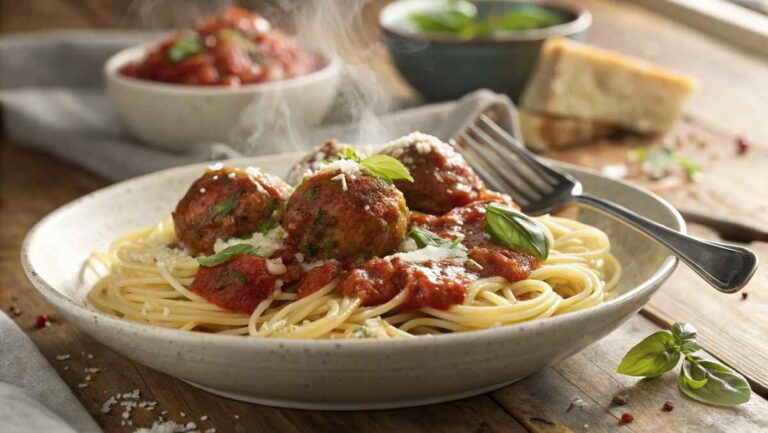
Gluten-Free Meatball With Pasta
This Classic Gluten-Free Meatball Pairings with Gluten-Free Pasta recipe delivers all the comfort and flavor of traditional Italian-style meatballs without any gluten. Juicy, flavorful meatballs are paired with gluten-free pasta and a rich, homemade marinara sauce. Whether you have gluten sensitivity, celiac disease, or just prefer a gluten-free diet, this dish is perfect for a cozy family dinner or a special occasion. Serve it with a side of fresh salad or roasted vegetables for a balanced meal.
- Total Time: 45 minutes
- Yield: 4 servings 1x
Ingredients
For the Gluten-Free Meatballs:
- 1 lb ground beef, turkey, or chicken
- ½ cup almond flour or gluten-free breadcrumbs
- 1 egg
- 1 teaspoon garlic powder
- 1 teaspoon onion powder
- 1 teaspoon Italian seasoning
- ½ teaspoon salt
- ½ teaspoon black pepper
- ¼ cup grated Parmesan cheese (optional)
- 2 tablespoons chopped fresh parsley
- 1 tablespoon olive oil (for frying)
For the Marinara Sauce:
- 2 tablespoons olive oil
- 1 small onion, finely chopped
- 3 cloves garlic, minced
- 1 (28 oz) can crushed tomatoes
- 1 teaspoon dried oregano
- 1 teaspoon dried basil
- ½ teaspoon salt
- ½ teaspoon black pepper
- 1 teaspoon sugar (optional, to balance acidity)
For the Pasta:
- 12 oz gluten-free pasta (spaghetti, penne, or fusilli)
- 1 teaspoon salt (for boiling water)
- 1 tablespoon olive oil (optional, to prevent sticking)
For Garnish:
- Fresh basil leaves, chopped
- Extra grated Parmesan cheese
- Red pepper flakes (optional, for heat)
Instructions
Step 1: Prepare the Meatballs
- In a large mixing bowl, combine ground meat, almond flour (or gluten-free breadcrumbs), egg, garlic powder, onion powder, Italian seasoning, salt, black pepper, Parmesan cheese, and chopped parsley. Mix gently until just combined.
- Using your hands, roll the mixture into small meatballs, about 1 to 1.5 inches in diameter.
- Heat 1 tablespoon of olive oil in a large skillet over medium heat. Add the meatballs and cook until browned on all sides, about 8-10 minutes. Remove from the skillet and set aside.
Step 2: Make the Marinara Sauce
- In the same skillet, heat 2 tablespoons of olive oil over medium heat. Add chopped onions and sauté until softened, about 3-4 minutes.
- Add minced garlic and cook for another 30 seconds until fragrant.
- Pour in crushed tomatoes, and stir in oregano, basil, salt, black pepper, and sugar. Bring to a simmer and let cook for 15-20 minutes, stirring occasionally.
Step 3: Cook the Gluten-Free Pasta
- While the sauce is simmering, bring a large pot of salted water to a boil. Add gluten-free pasta and cook according to package instructions, typically 8-12 minutes.
- Drain the pasta and toss with 1 tablespoon of olive oil to prevent sticking.
Step 4: Combine and Serve
- Add the cooked meatballs into the marinara sauce and let them simmer for 5 minutes to absorb the flavors.
- Plate the pasta and top with meatballs and marinara sauce.
- Garnish with fresh basil, grated Parmesan cheese, and red pepper flakes (if desired).
- Serve warm and enjoy!
Notes
- Meat Selection: Ground beef provides a rich taste, while turkey or chicken offers a leaner option.
- Breadcrumb Substitute: Almond flour adds a slight nuttiness, but gluten-free breadcrumbs give a more traditional texture.
- Make-Ahead Option: Cooked meatballs and sauce can be refrigerated for up to 3 days or frozen for 3 months for easy meal prep.
- Pasta Choice: Different gluten-free pasta brands vary in texture; some taste better than others. Try brands like Barilla Gluten-Free, Jovial, or Banza for the best results.
- Extra Veggies: For added nutrition, stir sautéed mushrooms, bell peppers, or zucchini into the sauce.
- Prep Time: 15 minutes
- Cook Time: 30 minutes
- Category: Main Course
- Method: Stovetop
- Cuisine: Italian
- Diet: Gluten Free
Nutrition
- Serving Size: 1 plate (meatballs with pasta and sauce)
- Calories: 480 kcal
- Sugar: 7g
- Sodium: 580mg
- Fat: 22g
- Saturated Fat: 6g
- Unsaturated Fat: 13g
- Trans Fat: 0g
- Carbohydrates: 46g
- Fiber: 6g
- Protein: 28g
- Cholesterol: 75mg
Keywords: gluten-free meatballs, gluten-free pasta, gluten-free Italian recipes, healthy pasta recipes, gluten-free dinner, easy meatball recipe, homemade marinara sauce, gluten-free comfort food
🍝 With Gluten-Free Pasta
One of the most traditional and satisfying ways to enjoy gluten-free meatballs is by pairing them with gluten-free pasta and a rich, flavorful sauce. Whether you prefer classic marinara, creamy Alfredo, or a fresh basil pesto, the right sauce will enhance the flavors of the meatballs while keeping the meal gluten-free.
Serving Tips:
- Use gluten-free spaghetti, penne, or fusilli for a comforting, traditional pasta dish.
- Top with fresh basil and grated Parmesan for added flavor.
- If you love creamy textures, try serving your meatballs with a rich burrata cheese topping, as seen in this guide on pasta dishes with burrata.
🥗 Over a Fresh Salad
For a light yet protein-packed meal, place your gluten-free meatballs over a crisp, fresh salad. This is a great option for those looking for a low-carb, high-protein meal with plenty of nutrients.
Best Salad Combinations:
- Mediterranean-style salad: Mixed greens, cherry tomatoes, cucumbers, olives, and a light vinaigrette.
- Caesar salad: Romaine lettuce, gluten-free croutons, and a creamy homemade Caesar dressing.
- Spinach and pesto salad: Drizzle some homemade spinach pesto over your salad for a burst of flavor. Try this spinach pesto recipe for inspiration!
🍚 With Rice or Quinoa
If you want a gluten-free alternative to pasta, serve your meatballs over rice or quinoa. This option keeps your meal hearty and satisfying while ensuring it’s completely gluten-free.
Best Ways to Serve:
- Garlic butter rice: Simple, flavorful, and pairs well with Italian-seasoned meatballs.
- Quinoa bowl: Combine meatballs with roasted vegetables, avocado, and a tahini dressing for a wholesome meal.
- Cilantro-lime rice: A fresh and zesty pairing that works well with Mexican-inspired meatballs.
🫓 In a Wrap – Gluten-Free Tortilla or Lettuce Wrap
For a more handheld and portable meal, wrap your gluten-free meatballs in a gluten-free tortilla or a large lettuce leaf. This is a great option for meal prep and works well for both lunch and dinner.
Wrap Ideas:
- Classic Meatball Wrap: Use gluten-free tortillas, add some fresh veggies, and drizzle with a tangy sauce.
- Lettuce Wraps: Opt for crisp butter lettuce for a low-carb, keto-friendly alternative.
- Mediterranean Wrap: Stuff your meatballs into a gluten-free pita or wrap with tzatziki sauce, cucumbers, and feta cheese.
If you enjoy low-carb meal options, check out these low-carb tortilla chips with homemade salsa for another delicious pairing! Are corn tortilla chips low-carb?
More Creative Ways to Serve Gluten-Free Meatballs
Aside from the classic options, there are plenty of creative ways to incorporate gluten-free meatballs into different meals:
🔥 As an Appetizer: Serve your meatballs with gluten-free dipping sauces, such as BBQ, honey mustard, or garlic aioli.
🍲 In a Soup: Add meatballs to a gluten-free vegetable or noodle soup for extra protein.
🍕 On a Gluten-Free Pizza: Slice meatballs and use them as a protein-packed pizza topping.
🥖 In a Sub Sandwich: Use gluten-free bread to make a hearty meatball sub with marinara sauce and melted cheese.
Are all meatballs gluten-free?
No, many traditional meatballs contain breadcrumbs, flour, or gluten-based sauces. Always check the ingredients or make your own using gluten-free alternatives.
What is the best gluten-free binder for meatballs?
Great options include almond flour, oats, crushed gluten-free crackers, or mashed potatoes.
Can I freeze gluten-free meatballs?
Yes! Store cooked or uncooked meatballs in an airtight container for up to 3 months. Learn more about freezing homemade dishes.
What are the best sauces for gluten-free meatballs?
- Gluten-Free Marinara Sauce – A classic Italian pairing.
- Homemade Teriyaki Sauce – Use gluten-free soy sauce to make it safe.
- Gluten-Free Pesto – Try this delicious spinach pesto recipe.
Final Thoughts: Are Meatballs Gluten-Free?
So, are meatballs gluten-free? The answer depends on the ingredients. While traditional meatball recipes often contain gluten from breadcrumbs, flour, and sauces, making them unsuitable for those with gluten sensitivities, there are plenty of delicious gluten-free alternatives that allow you to enjoy this classic dish without worry.
Why Choose Gluten-Free Meatballs?
Choosing gluten-free meatballs isn’t just about avoiding gluten—it’s about making healthier and more inclusive meal choices. Whether you have celiac disease, gluten intolerance, or simply want to reduce gluten in your diet, opting for gluten-free meatballs ensures that everyone at the table can enjoy a delicious and satisfying meal.
Additionally, gluten-free meatballs often incorporate nutrient-rich alternatives like almond flour, oats, or mashed potatoes, which not only serve as excellent binders but also provide additional fiber, protein, and essential vitamins. This means you’re not just cutting out gluten; you’re enhancing the nutritional value of your meals.
Making, Buying, and Serving Gluten-Free Meatballs
By following this guide, you now have all the information needed to make, buy, and serve gluten-free meatballs with confidence. Here’s a quick recap:
- Making Gluten-Free Meatballs at Home: Use almond flour, gluten-free breadcrumbs, crushed crackers, or oats instead of regular breadcrumbs. Be sure to check your seasonings and sauces for hidden gluten.
- Buying Store-Bought Gluten-Free Meatballs: Always check labels for a certified gluten-free mark and avoid any products with wheat, barley, or rye. Stick to trusted gluten-free brands that ensure quality and safety.
- Serving Gluten-Free Meatballs: Pair them with gluten-free pasta, rice, fresh salads, or roasted vegetables for a balanced and satisfying meal.
Enjoying a Gluten-Free Lifestyle with Delicious Options
Gluten-free eating doesn’t have to be restrictive. With simple ingredient swaps and careful label reading, you can continue enjoying all your favorite meals, including meatballs, without worry. Plus, experimenting with different gluten-free binders, seasonings, and sauces can enhance the flavor and texture of your meals, making them even more enjoyable than traditional recipes.
If you’re looking to expand your gluten-free meal options, don’t stop at meatballs! Explore other gluten-free comfort foods and delicious recipes:
🍝 Love pasta? Try these gluten-free pasta dishes.
🥗 Need a side dish? A fresh spinach pesto makes the perfect dip or topping.
🍞 Looking for gluten-free baked goods? Check out this guide to gluten-free muffins.
Are Meatballs Gluten-Free? Yes, They Can Be!
Traditional meatballs may not be gluten-free, but with a few easy swaps, you can create a safe, flavorful, and satisfying version that fits any dietary need. Whether you choose to make your own at home or find a trusted store-bought brand, gluten-free meatballs are a fantastic option that everyone can enjoy.
🚀 Want more gluten-free meal inspiration? Check out our best gluten-free recipes and start cooking today!

